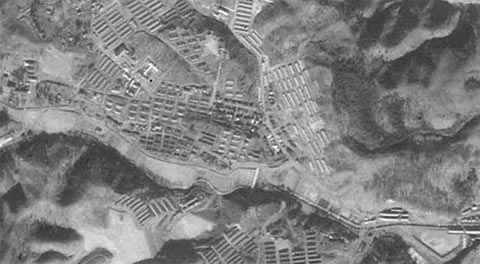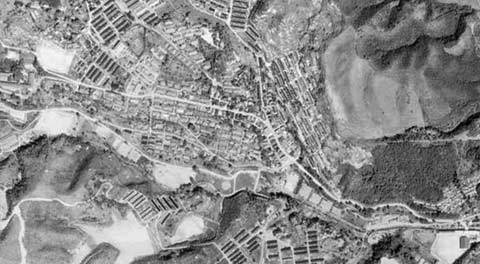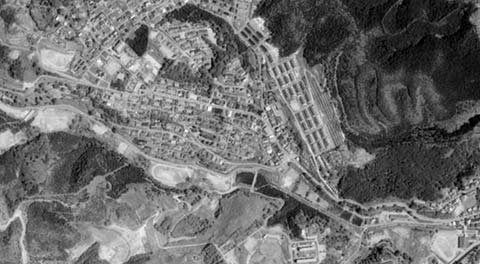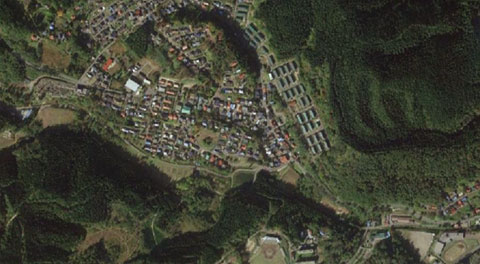Osarizawa Mine
The mine is situated in the upper Yoneshiro River basin, and its ore deposits were scattered over an area of two kilometers from east to west and three kilometers from north to south around Mt. Omori.
According to legend, the mine was discovered in 708 and supplied gold for gilding the Great Buddha of Todai-ji Temple and the Konjikido of Chuson-ji Temple in Hiraizumi in ancient times.
From the late 16th century, gold veins were discovered throughout Osarizawa, including Saido and Gojumai, and Osarizawa became known as a gold-producing area controlled by the Kinzan Bugyo, the magistrate of gold mines.
While the gold mines waned in the late 17th century, copper ore deposits were discovered by Juzaemon Nagao, a prospector, at Tagorisawa in 1666.
Taking this opportunity, copper mine development flourished throughout Osarizawa, and mines were managed either as private Ukeyama by prospectors and merchants or as public Jikiyama by the Morioka Domain.
Crude copper produced at the mines was shipped to Osaka-Doza, the copper monopoly and the guild established by the shogunate, where it was refined into ingots by Dofukiya, the refining operators, in order to be used for trade settlements.
In 1754, the mine became one of the three largest copper mines supplying the shogunate with copper for the Nagasaki Trade with Ani and Besshi mines.
During the feudal period, production at the mine peaked in 1865, reaching 4,772 tonnes of crude ore and 651 tonnes of crude copper.
In the Meiji period, mining rights were successively transferred to several managers, including Heizo Okada, and eventually reached Mitsubishi Company in 1889.
The company expanded its mining areas and strove for the modernization of mining equipment.
Then the mine steadily increased production, and it reached 855,647 tonnes of crude ore and 7,807 tonnes of crude copper in its peak year of 1943.
The number of employees reached a peak of 3,979 in the following year.
After the war, annual production of crude ore exceeded 700,000 tonnes from the 1960s owing to refurbishment of production equipment and changes in mining methods.
However, the quality of the ore declined along with the copper price around that time.
The company closed the smelter at the mine in 1966 and eliminated approximately 800 jobs two years later.
Afterwards, the mining works was spun off into Osarizawa Mine Co., Ltd. in 1972, and its operations were inherited.
The large-scale mining facilities remain today in the vast grounds.
closure in 1978
Shishizawa, Osarizawa, Kazuno City, Akita
copper, gold, silver, lead, zinc, iron sulfide
尾去沢では江戸末期の慶応年間に行われた発破試験をはじめ、明治初期に採用された蒸気機関や削岩機など、積極的に近代技術が導入されます。
その後、三菱のもとで水力発電所の設置と坑内外設備の電化が図られ、鉱山は発展に向かうこととなりました。
坑内では元山、田郡、赤沢の 3 区域に分けて開発が進められ、軌道の敷設、竪坑の開削、巻揚機の増設の他、昭和初期には幹線坑道への電気、ガソリン機関車の設置が行われます。
鉱山と秋田鉄道尾去沢駅(後の土深井駅)との間には大正初期に馬車軌道が敷設され、花輪線陸中花輪駅(後の鹿角花輪駅)との間には昭和初期に索道が架設されました。
選鉱、製錬設備は増産に応じて拡張と強化が重ねられ、火災や雪崩に見舞われながらも復旧とともに改良が施されます。
広大な敷地には月産 10 万 t の処理能力を誇る国内最大級の選鉱場と、長大な煙道に加えて高さ 60 m の煙突を備えた製錬所が隣接し、周辺では煙害による森林の減少が進みました。
The mine introduced modern mining technology, such as experimental blasting in the middle of the 19the century and employing rock drills along with a steam engine at the end of the 19th century.
Then Mitsubishi established hydraulic power plants, which enabled the electrification and large-scale development of the mine.
The company divided the mining areas into three zones, namely, Motoyama, Tagori, and Akasawa, and planned mine development.
Afterwards, the mine increased its production by introducing initiatives, such as laying underground tracks, excavating vertical shafts, increasing the number of windlasses, and installing electric and gasoline locomotives.
The company constructed an aerial tramway in the first half of the 20th century between the mine and Rikuchu-Hanawa Station, later Kazuno-Hanawa Station, on the Hanawa Line in addition to a horse-drawn track between the mine and Osarizawa Station, later Dobukai Station, on the Akita Railway.
The beneficiation and smelting equipment suffered disasters such as fires and an avalanche.
However they were restored on each occasion, and their capacities were extended.
The beneficiation plant was one of the largest in the nation with the high processing capability of 100,000 tonnes per month.
The neighboring smelter has large flues and a chimney with a height of 60 meters, which caused a reduction in forests due to smoke pollution.
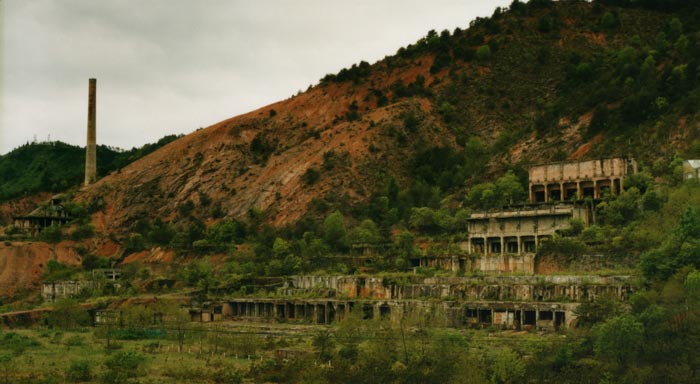
#01
大盛山の一帯には東に赤沢、西に元山、田郡、南に長坂、北に西道、崎山などの多くの鉱区が散在します。
幕末に至るまで、各鉱区は単独の鉱山として稼行されました。
Around Mt. Omori, there were a large number of ore vein groups, including Akasawa in the east, Motoyama and Tagori in the west, Nagasaka in the south, and Saido and Sakiyama in the north.
Each of them was independently developed as a separate mine until the middle of the 19th century.
View Details
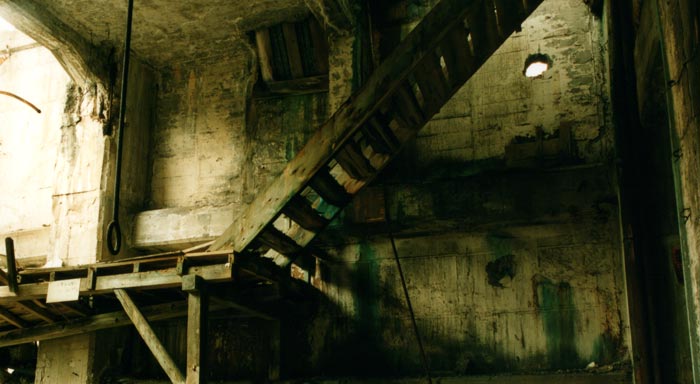
#02
米代川の北岸に位置する白根金山は、尾去沢に先んじて産金で繁栄し、後に小真木鉱山として銅鉱を産出します。
三菱のもとでは細地、大葛鉱山などとともに尾去沢の支山とされました。
Shirane Gold Mine, situated on the north bank of the Yoneshiro River, was known as a gold mine predating Osarizawa Mine and later produced copper ore as Komaki Mine.
The mine, along with Hosoji, Okuzo, and other mines, was operated as part of Osarizawa Mine under the management of Mitsubishi.
View Details
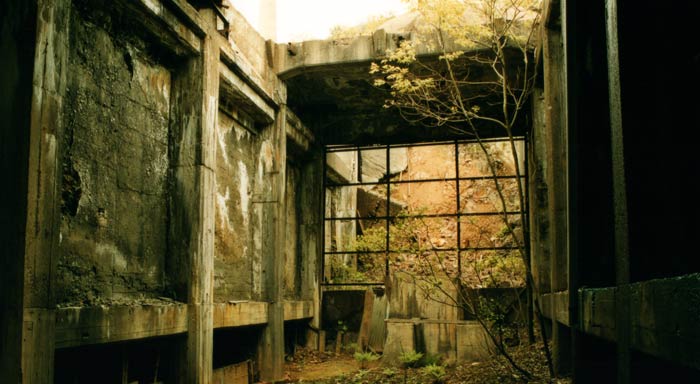
#03
周辺には多くの社宅や鉱員住宅が並び、病院、託児所、幼稚園、小学校、劇場、運動場、寺社などを備えた鉱山町が築かれて賑わいました。
一部は残され、現在も活用されています。
A mining town built in the vicinity comprised company houses, miners' houses, a hospital, a day nursery, a kindergarten, an elementary school, a theater, sports grounds, shrines, temples, and other facilities.
Some of them are utilized for other purposes and can still be seen today.
View Details

#04
1936 年(昭和 11 年)に鉱山の北東部に位置する中沢鉱滓ダムが 2 度にわたって決壊し、複数の集落が泥流に襲われます。
301 戸が全半壊し、374 名の死者を出す大惨事となりました。
The Nakazawa Tailings Dam, situated on the northeastern side of the mine, collapsed twice in 1936, causing significant damage to a settlement along the stream.
Consequently, the number of completely and partially destroyed houses totaled 301, and the total death toll rose to 374.
View Details
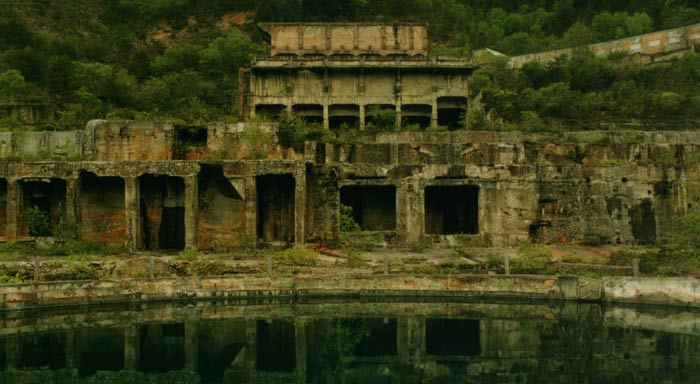
#05
戦況が悪化する中、尾去沢では軍需省の要請のもとに月産 10 万 t の増産体制が敷かれ、朝鮮人 687 名が徴用された他、中国人 498 名、連合軍捕虜 545 名が過酷な労働を強いられました。
Toward the end of the Pacific War, the company expanded production capacity to 100,000 tonnes per month in response to demand from the Ministry of Munitions.
Around the same period, 687 Koreans, 498 Chinese, and 545 Allied prisoners of war were compelled to work.
View Details
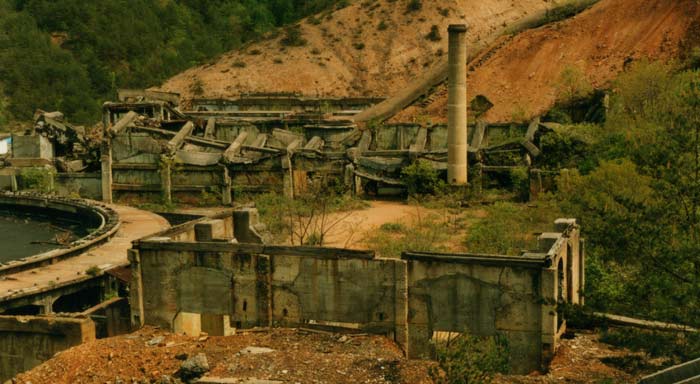
#06
稼行対象とされた鉱脈は合計 560 条 24 鉱脈群、坑道の総延長は 800 km に及び、三菱のもとで粗鉱 2,850 万 t、銅 30 万 t、金 4.4 t、銀 155 t、鉛、亜鉛各 1 万 t ほどが生産されました。
The mine had 560 ore veins in 24 groups, and the total length of the mine tunnels reached 800 kilometers.
In total, Mitsubishi produced 28.5 million tonnes of crude ore, 300,000 tonnes of copper, 4.4 tonnes of gold, 155 tonnes of silver, and 10,000 tonnes of lead and zinc each.
View Details



